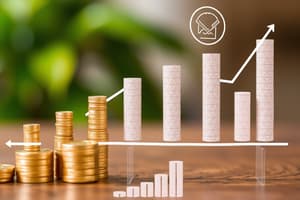Podcast
Questions and Answers
Which statement accurately describes the concept of opportunity cost?
Which statement accurately describes the concept of opportunity cost?
- The total gain from all options when a choice is made.
- The expense related to the closest alternative that is not chosen. (correct)
- The cost incurred for all possible alternatives in a market.
- The overall cost of resources used in production.
In a perfectly competitive market, which characteristic is NOT typical?
In a perfectly competitive market, which characteristic is NOT typical?
- Many buyers and sellers.
- Free entry and exit.
- Homogeneous products.
- High barriers to entry. (correct)
Which economic indicator would be the best measure of a country's economic output?
Which economic indicator would be the best measure of a country's economic output?
- Inflation Rate
- Unemployment Rate
- Consumer Price Index
- Gross Domestic Product (GDP) (correct)
What is the primary function of fiscal policy in an economy?
What is the primary function of fiscal policy in an economy?
Which type of economy best describes a system where the government makes all economic decisions?
Which type of economy best describes a system where the government makes all economic decisions?
Which market structure is characterized by a few sellers controlling most of the market?
Which market structure is characterized by a few sellers controlling most of the market?
What did the law of supply and demand establish as the point where market equilibrium occurs?
What did the law of supply and demand establish as the point where market equilibrium occurs?
In the context of economics, what role do incentives play in decision-making?
In the context of economics, what role do incentives play in decision-making?
Flashcards are hidden until you start studying
Study Notes
Definition of Economics
- The study of how individuals, businesses, and governments allocate scarce resources to satisfy unlimited wants.
- Examines production, distribution, and consumption.
Key Concepts
-
Scarcity
- Limited availability of resources compared to unlimited wants.
-
Supply and Demand
- Supply: The amount of a good or service that producers are willing to sell.
- Demand: The desire for a good or service by consumers.
- Market equilibrium occurs where supply equals demand.
-
Opportunity Cost
- The cost of the next best alternative forgone when making a choice.
-
Incentives
- Factors that motivate individuals to act in certain ways, affecting economic decisions.
Types of Economics
-
Microeconomics
- Focuses on individual consumers and businesses.
- Analyzes market behavior and decision-making processes.
-
Macroeconomics
- Studies the economy as a whole.
- Examines large-scale economic factors like inflation, unemployment, and GDP.
Economic Systems
-
Market Economy
- Decisions made by individuals and businesses based on supply and demand.
-
Command Economy
- Government makes all economic decisions and controls resources.
-
Mixed Economy
- Combines elements of market and command economies.
Economic Indicators
- Gross Domestic Product (GDP): Measures total economic output.
- Unemployment Rate: Percentage of the labor force that is jobless.
- Inflation Rate: Rate at which the general level of prices for goods and services rises.
Market Structures
-
Perfect Competition
- Many buyers and sellers, homogeneous products, free entry and exit.
-
Monopoly
- Single seller dominates the market, unique product, high barriers to entry.
-
Oligopoly
- Few sellers control most of the market, products may be identical or differentiated.
-
Monopolistic Competition
- Many competitors with differentiated products.
Fiscal and Monetary Policy
- Fiscal Policy: Government adjusts spending and taxation to influence the economy.
- Monetary Policy: Central bank controls money supply to manage inflation and interest rates.
Conclusion
- Economics is a broad field that addresses how resources are allocated and the implications of economic decisions. Understanding these concepts provides insight into market dynamics and policy impacts on society.
Definition of Economics
- Economics analyzes allocation of scarce resources to meet unlimited needs.
- It focuses on processes of production, distribution, and consumption across various sectors.
Key Concepts
- Scarcity: Refers to the limited availability of resources versus boundless human desires.
- Supply and Demand:
- Supply involves the quantity of goods producers are willing to sell.
- Demand reflects consumer desire for goods and services.
- Market equilibrium is achieved when supply meets demand, balancing prices.
- Opportunity Cost: Represents the value of the next best alternative foregone when a choice is made.
- Incentives: Motivating factors influencing individual and business decisions, shaping economic behavior.
Types of Economics
- Microeconomics: Examines decision-making processes of individuals and businesses, focusing on market dynamics.
- Macroeconomics: Investigates larger economic factors such as national inflation rates, unemployment levels, and gross domestic product (GDP).
Economic Systems
- Market Economy: Relies on individual and business decisions driven by supply and demand without central regulation.
- Command Economy: Government centrally plans all economic activities and controls resource allocation.
- Mixed Economy: Integrates aspects of both market and command economies, leveraging private enterprise with government intervention.
Economic Indicators
- Gross Domestic Product (GDP): Quantifies total economic output, serving as a key indicator of economic health.
- Unemployment Rate: Represents the percentage of active labor force seeking jobs but unable to find employment.
- Inflation Rate: Measures the pace at which overall price levels for goods and services rise, often affecting purchasing power.
Market Structures
- Perfect Competition: Characterized by many buyers and sellers, identical products, and ease of market entry and exit.
- Monopoly: Dominated by a single supplier offering a unique product, with significant barriers to entry for competitors.
- Oligopoly: Consists of few sellers holding a large market share, with products that may be standardized or varied.
- Monopolistic Competition: Numerous competitors present differentiated products, each with some market power.
Fiscal and Monetary Policy
- Fiscal Policy: Government efforts involving adjustments in spending and taxation aimed at influencing the economy's performance.
- Monetary Policy: Actions by a central bank to regulate money supply and control inflation and interest rates.
Conclusion
- Economics encompasses a wide range of topics focusing on resource allocation and its broader societal implications.
- Grasping these core concepts enhances understanding of market behaviors and the effects of policies on the economy.
Studying That Suits You
Use AI to generate personalized quizzes and flashcards to suit your learning preferences.




